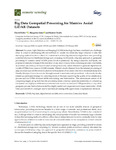Mostrar o rexistro simple do ítem
Big Data Geospatial Processing for Massive Aerial LiDAR Datasets
| dc.contributor.author | Deibe, David | |
| dc.contributor.author | Amor, Margarita | |
| dc.contributor.author | Doallo, Ramón | |
| dc.date.accessioned | 2020-03-23T15:07:02Z | |
| dc.date.available | 2020-03-23T15:07:02Z | |
| dc.date.issued | 2020-02-21 | |
| dc.identifier.citation | Deibe, D.; Amor, M.; Doallo, R. Big Data Geospatial Processing for Massive Aerial LiDAR Datasets. Remote Sens. 2020, 12, 719. | es_ES |
| dc.identifier.issn | 2072-4292 | |
| dc.identifier.uri | http://hdl.handle.net/2183/25219 | |
| dc.description.abstract | [Abstract] For years, Light Detection and Ranging (LiDAR) technology has been considered as a challenge when it comes to developing efficient software to handle the extremely large volumes of data this surveying method is able to collect. In contexts such as this, big data technologies have been providing powerful solutions for distributed storage and computing. In this work, a big data approach on geospatial processing for massive aerial LiDAR point clouds is presented. By using Cassandra and Spark, our proposal is intended to support the execution of any kind of heavy time-consuming process; nonetheless, as an initial case of study, we have focused on fast ground-only rasters obtention to generate digital terrain models (DTMs) from massive LiDAR datasets. Filtered clouds obtained from the isolated processing of adjacent zones may exhibit errors located on the boundaries of the zones in the form of misclassified points. Usually, this type of error is corrected through manual or semi-automatic procedures. In this work, we also present an automated strategy for correcting errors of this type, improving the quality of the classification process and the DTMs obtained while minimizing user intervention. The autonomous nature of all computing stages, along with the low processing times achieved, opens the possibility of considering the system as a highly scalable service-oriented solution for on-demand DTM generation or any other geospatial process. Said solution would be a highly useful and unique service for many users in the LiDAR field, and one which could get near to real-time processing with appropriate computational resources. | es_ES |
| dc.description.sponsorship | Xunta de Galicia; ED431C 2017/04 | es_ES |
| dc.description.sponsorship | Consolidation Programme of Competitive Research Units; R2016/037 | es_ES |
| dc.description.sponsorship | Xunta de Galicia; ED431G/01 | es_ES |
| dc.description.sponsorship | Ministerio de Economía y Competitividad; TIN2016-75845-P | es_ES |
| dc.language.iso | eng | es_ES |
| dc.publisher | M D P I AG | es_ES |
| dc.relation.uri | https://doi.org/10.3390/rs12040719 | es_ES |
| dc.rights | Atribución 3.0 España | es_ES |
| dc.rights.uri | http://creativecommons.org/licenses/by/3.0/es/ | * |
| dc.subject | LiDAR | es_ES |
| dc.subject | Big data | es_ES |
| dc.subject | Digital terrain models | es_ES |
| dc.subject | Error correction | es_ES |
| dc.subject | Cassandra | es_ES |
| dc.subject | Spark | es_ES |
| dc.title | Big Data Geospatial Processing for Massive Aerial LiDAR Datasets | es_ES |
| dc.type | info:eu-repo/semantics/article | es_ES |
| dc.rights.access | info:eu-repo/semantics/openAccess | es_ES |
| UDC.journalTitle | Remote Sensing | es_ES |
| UDC.volume | 12 | es_ES |
| UDC.issue | 4 | es_ES |
| UDC.startPage | 719 | es_ES |
| dc.identifier.doi | 10.3390/rs12040719 |
Ficheiros no ítem
Este ítem aparece na(s) seguinte(s) colección(s)
-
GI-GAC - Artigos [180]






